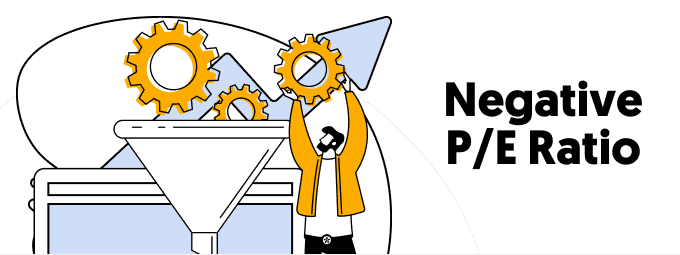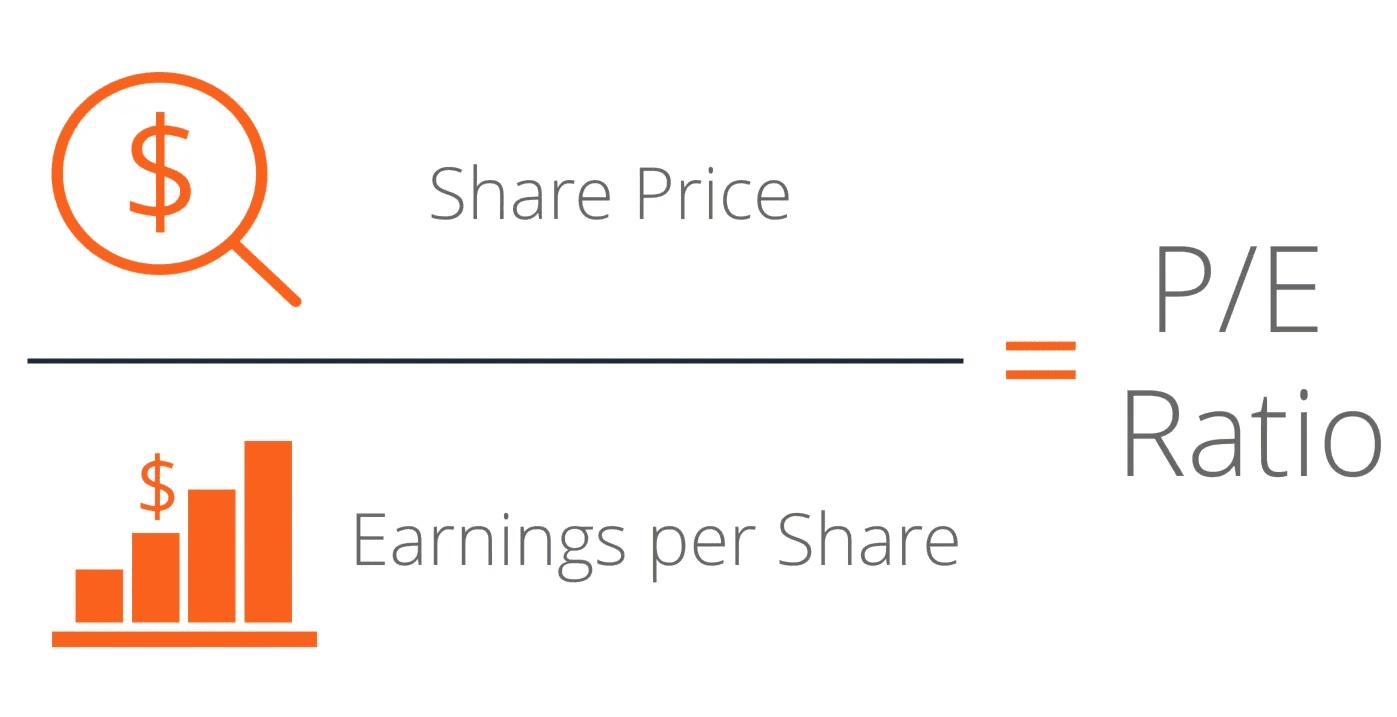Imagine stumbling upon a stock with a negative P/E ratio. Is it a red flag signaling impending doom or a potential hidden gem? Understanding negative P/E ratios can demystify this seemingly counterintuitive phenomenon and help you make informed investment decisions. In this blog post, we will be exploring their causes, evaluating companies with such ratios, assessing risks and opportunities, and equipping you with strategies to navigate this intriguing aspect of stock analysis.
Short Summary
Understanding negative P/E ratios can help investors identify investment opportunities.
Evaluating financial statements, comparing companies within the same industry and considering growth prospects are important when investing in stocks with negative P/E ratios.
Diversifying portfolios, setting realistic expectations and monitoring stock performance are strategies for successful investments in these stocks.
Understanding Negative P/E Ratios

A negative P/E ratio occurs when a company has negative earnings per share (EPS), indicating a loss or no profits in the past 12 months. It’s like an alarm bell for investors, signaling that the company is experiencing negative EPS and losing money.
But is it always a bad investment? Not necessarily. By comprehending the factors behind negative P/E ratios, you can identify unique investment opportunities and make well-informed decisions.
The Basics of P/E Ratios
P/E ratio, or price-to-earnings ratio, measures a company’s stock price relative to its earnings per share, helping investors gauge the relative value of stocks. A higher P/E ratio may suggest that the stock is overvalued, while a lower ratio may indicate an undervalued stock. It’s like a yardstick that helps investors compare companies and determine their investment potential.
However, when a company has negative earnings, the P/E ratio becomes negative, making it challenging to assess the stock’s value. In such cases, it is crucial to look beyond the P/E ratio and understand the factors that led to the company’s earnings being negative, as well as considering the earnings yield as an alternative valuation metric.
Three Variants of the P/E Ratio
There are three variants of the P/E ratio:
Trailing P/E ratio: This is the most common type of P/E ratio. It is calculated by dividing the current share price by the earnings per share (EPS) over the previous 12 months.
Forward P/E ratio: This ratio is calculated by dividing the current share price by the estimated EPS for the next 12 months.
Shiller P/E ratio: This ratio is calculated by dividing the current share price by the average EPS over the past 10 years, adjusted for inflation.
It is best to use multiple P/E ratios to evaluate a stock. By comparing different P/E ratios, you can get a better sense of how investors are valuing the company’s earnings. You can also compare the P/E ratios of a company to the P/E ratios of other companies in the same industry to see if the stock is undervalued or overvalued.
Here is a table that summarizes the three P/E ratios:
| P/E Ratio | Calculation | Strengths | Weaknesses |
|---|---|---|---|
| Trailing P/E ratio | Current share price / EPS over the previous 12 months | Widely used, easy to understand | Can be misleading if a company has had unusual earning in the past 12 months |
| Forward P/E ratio | Current share price / estimated EPS for the next 12 months | More forward-looking, less volatile | Can be more volatile and unpredicatble |
| Shiller P/E ratio | Current share price / average EPS over the past 10 years, adjusted for inflation | Less volatile and unpredictable, more timely | Less widely used, harder to understand |
Trailing vs Forward P/E Ratios
The trailing P/E ratio and the forward P/E ratio are both valuation metrics that investors use to compare the price of a stock to its earnings. However, they are calculated differently and have different strengths and weaknesses.
Trailing P/E ratio is calculated by dividing the current share price by the earnings per share (EPS) over the previous 12 months. It is a backward-looking measure that reflects how much investors are paying for the company’s past earnings.
Forward P/E ratio is calculated by dividing the current share price by the estimated EPS for the next 12 months. It is a forward-looking measure that reflects how much investors are paying for the company’s expected earnings.
It is best to use both the trailing P/E ratio and the forward P/E ratio to evaluate a stock. By comparing the two ratios, you can get a better sense of how investors are valuing the company’s past earnings and its expected earnings. You can also compare the ratios to the P/E ratios of other companies in the same industry to see if the stock is undervalued or overvalued.
Determining if a Stock has a Negative P/E Ratio

To find out if a stock has a negative P/E ratio, you’ll need to know how to calculate a P/E ratio. To do so, you divide the stock price with the earnings per share (EPS), like this:
P/E Ratio = Price Per Share (Market Value)/ Earnings Per Share (EPS)
For example, say Company X has a share price of $80 and its earnings last year were $20 per share. Using the above formula, you would divide 80 by 20 and get the P/E ratio of 4.
Now let’s say a year later the company’s stock price goes up to $100 but it reported a negative EPS of minus $10. Then it would have a negative P/E ratio of -10. If a company has negative earnings, it often means it was losing money over the past 12 months.
Factors Leading to Negative P/E Ratios
Negative P/E ratios can stem from various factors, such as a company’s growth phase, restructuring efforts, changes to accounting methods, changes to appreciation or amortization, or temporary setbacks in financial performance.
It’s essential to identify the cause behind the negative P/E ratio and determine whether it’s a temporary issue or a sign of deeper financial troubles. By considering these factors, you can make better investment decisions and potentially uncover hidden opportunities.
Analyzing Companies with Negative P/E Ratios
To fully grasp the potential of investing in companies with negative P/E ratios, a thorough analysis is required. This involves evaluating financial statements, comparing companies within the same industry, and considering growth prospects.
By assessing these factors, you can identify potential investment opportunities and minimize the risks associated with negative P/E ratios.
Evaluating Financial Statements
Reviewing a company’s financial statements, such as the income statement, balance sheet, and cash flow statement, can provide valuable insights into its financial health. For example, consistently declining revenues, increasing debt levels, or poor cash flow may indicate a company’s inability to generate profits in the future.
On the other hand, a company with a temporary setback or a promising growth plan may still be a sound investment despite having a negative P/E ratio. By examining financial statements, investors can identify potential red flags or opportunities and make better investment decisions.
Comparing Companies within the Same Industry

Another crucial aspect of analyzing companies with negative P/E ratios is comparing them to their peers within the same industry. Industry comparison helps investors assess the relative performance and valuation of stocks with negative P/E ratios. For example, if most companies within an industry have negative P/E ratios, it could be due to industry-specific factors or market conditions, rather than individual company performance.
However, if a company consistently underperforms its peers in the same industry, it may signal potential problems that warrant further investigation. By comparing companies within the same industry, investors can gain a better understanding of the industry’s landscape and make more informed decisions about their investments.
Considering Growth Prospects
Growth prospects, including a company’s earnings growth and growth ratio, play a significant role in determining the investment potential of companies with negative P/E ratios. A company with promising future prospects, such as a strong competitive advantage, potential for new products or services, or expansion into new markets, may still be a good investment despite having a negative P/E ratio.
Investors should also evaluate the company’s management quality, market share, and size when considering growth prospects. By considering these factors, investors can identify companies with negative P/E ratios that may have promising future potential.
Risks and Opportunities Associated with Negative P/E Ratios
Investing in stocks with negative P/E ratios can be both risky and rewarding. Understanding the risks and potential rewards associated with such investments is crucial for making well-informed decisions.
In this section, we will explore the warning signs to watch out for as well as discuss the potential benefits.
Warning Signs to Watch Out For
When investing in stocks with negative P/E ratios, it’s essential to be aware of potential warning signs. Persistent losses, high debt levels, and poor cash flow may indicate a company’s inability to turn a profit in the future. If a company has had a negative P/E ratio for an extended period, investors may wish to review its financial statements to determine its financial health.
By being vigilant and aware of these warning signs, investors can better manage their risks and avoid investing in companies with potentially poor future prospects.
Potential Benefits of Investing in Negative P/E Stocks
Despite the risks, there are potential benefits to investing in stocks with negative P/E ratios. Such stocks may offer growth opportunities, undervalued assets, or the possibility of a turnaround in financial performance. In the example we mentioned earlier, a young startup with high expenses and little revenue may have a negative P/E ratio due to its growth phase. However, if the company’s growth prospects are strong, it may still be a worthwhile investment.
By identifying and capitalizing on these potential benefits, investors can potentially maximize returns and minimize risks associated with investing in stocks with negative P/E ratios.
Other Important Financial Metrics to Consider
When evaluating stocks with negative P/E ratios, it’s essential to consider other financial metrics that can provide additional insights into a company’s financial health and potential for growth.
In this section, we will delve into the debt-to-equity ratio, price-to-sales ratio, and cash flow analysis.
Related Article: Uncovering The CNN Fear And Greed Index: What It Is And How To Use It
Debt-to-Equity Ratio
The debt-to-equity ratio measures a company’s financial leverage by comparing its total liabilities to shareholder equity. A higher debt-to-equity ratio indicates that a company is more leveraged and may be more likely to struggle in meeting its debt commitments.
Analyzing a company’s debt-to-equity ratio can provide insight into its ability to manage debt and its overall financial stability.
Price-to-Sales Ratio
The price-to-sales ratio compares a company’s stock price to its revenue, offering an alternative valuation metric for companies with negative earnings. A higher price-to-sales ratio suggests that the company’s stock is comparatively pricier in relation to its sales, whereas a lower price-to-sales ratio implies that the company’s stock is comparatively cheaper in relation to its sales.
By considering the price-to-sales ratio and the stock’s current market price, investors can gain additional insights into the value of a company’s stock price relative to its sales.
Cash Flow Analysis
Cash flow analysis examines a company’s ability to generate cash from operations, which can be a crucial factor in determining a company’s financial stability and growth potential. Companies with strong cash flow are generally better positioned to invest in growth opportunities, service debt, and weather economic downturns during various stages of the business cycle.
Analyzing a company’s cash flow, along with other financial metrics, can provide a more comprehensive picture of its financial health and future prospects.
Strategies for Investing in Stocks with Negative P/E Ratios

Now that you’re armed with the knowledge of negative P/E ratios and their implications, it’s time to develop strategies for investing in stocks with negative P/E ratios. These strategies include diversifying your portfolio, setting realistic expectations, and monitoring stock performance.
Diversifying Your Portfolio
Diversifying your portfolio helps spread risk across various investments, reducing the impact of potential losses from stocks with negative P/E ratios. By investing in a mix of growth stocks, value stocks, and dividend stocks, you can achieve a more balanced investment portfolio and potentially enhance long-term returns.
Diversification also allows for the potential to capitalize on gains in other stocks or asset classes that may perform well even if some stocks with negative P/E ratios fail to meet expectations.
Related Article: The Best Book On Day Trading In 2023: Top 10 For Beginners To Experts
Setting Realistic Expectations
Setting realistic expectations is crucial when investing in stocks with negative P/E ratios. Understand the risks and potential rewards associated with such investments, including their impact on future earnings, and adjust your investment strategies accordingly.
Recognize that not all negative P/E stocks will turn into success stories, and be prepared for the possibility of losses as you should be with any investment.
Monitoring Stock Performance
Monitoring stock performance allows investors to track the progress of companies with negative P/E ratios and make informed decisions about whether to hold, buy, or sell these stocks. Regularly review a company’s financial statements, research analyst reports, and industry trends to stay up-to-date on the stock’s performance and the overall market conditions.
Summary
In conclusion, negative P/E ratios can be both a warning sign and an opportunity for investors. By understanding the factors that lead to negative P/E ratios, analyzing companies with such ratios, and employing effective investment strategies, you can make more informed decisions and potentially uncover hidden investment opportunities. Remember, the key to successful investing in stocks with negative P/E ratios lies in thorough analysis, diversification, setting realistic expectations, and vigilant monitoring of stock performance.
Frequently Asked Questions
What if a PE ratio is less than 10?
If a company has a PE ratio below 10, it may signal that the stock price is undervalued and can be a great opportunity for value investors.
This could mean that as the company’s earnings increase, its stock price stays the same, making it an attractive prospect for investors.
Is a low PE ratio good?
A low PE ratio is generally considered a good thing as it indicates that the share price is lower than earnings, making it an attractive choice for bargain-hunting investors.
A high PE ratio, on the other hand, suggests that the stock is expensive and its price may fall in the future.
What is a negative EPS ratio?
A negative EPS ratio reflects that a company is losing money, spending more than it earns. Despite this, it does not necessarily mean that the stock should be sold.
What factors can lead to negative P/E ratios?
Negative P/E ratios can arise due to a company’s growth phase, restructuring efforts or financial setbacks.
These factors can cause a company’s stock price to be lower than its earnings, resulting in a negative P/E ratio. This can be a sign of potential value for investors, as the stock can be a sign of potential value for investors.




